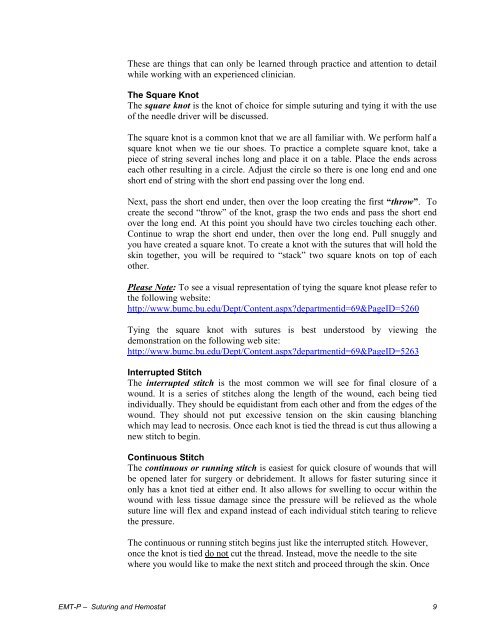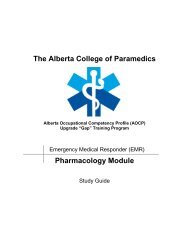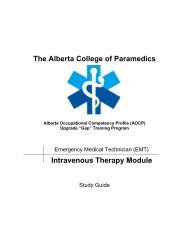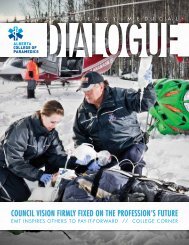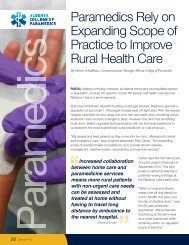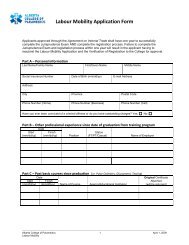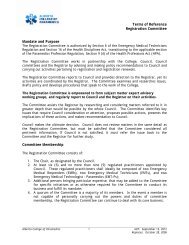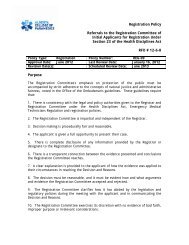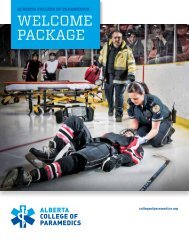Suturing and Hemostat - Alberta College of Paramedics
Suturing and Hemostat - Alberta College of Paramedics
Suturing and Hemostat - Alberta College of Paramedics
Create successful ePaper yourself
Turn your PDF publications into a flip-book with our unique Google optimized e-Paper software.
These are things that can only be learned through practice <strong>and</strong> attention to detailwhile working with an experienced clinician.The Square KnotThe square knot is the knot <strong>of</strong> choice for simple suturing <strong>and</strong> tying it with the use<strong>of</strong> the needle driver will be discussed.The square knot is a common knot that we are all familiar with. We perform half asquare knot when we tie our shoes. To practice a complete square knot, take apiece <strong>of</strong> string several inches long <strong>and</strong> place it on a table. Place the ends acrosseach other resulting in a circle. Adjust the circle so there is one long end <strong>and</strong> oneshort end <strong>of</strong> string with the short end passing over the long end.Next, pass the short end under, then over the loop creating the first “throw”. Tocreate the second “throw” <strong>of</strong> the knot, grasp the two ends <strong>and</strong> pass the short endover the long end. At this point you should have two circles touching each other.Continue to wrap the short end under, then over the long end. Pull snuggly <strong>and</strong>you have created a square knot. To create a knot with the sutures that will hold theskin together, you will be required to “stack” two square knots on top <strong>of</strong> eachother.Please Note: To see a visual representation <strong>of</strong> tying the square knot please refer tothe following website:http://www.bumc.bu.edu/Dept/Content.aspx?departmentid=69&PageID=5260Tying the square knot with sutures is best understood by viewing thedemonstration on the following web site:http://www.bumc.bu.edu/Dept/Content.aspx?departmentid=69&PageID=5263Interrupted StitchThe interrupted stitch is the most common we will see for final closure <strong>of</strong> awound. It is a series <strong>of</strong> stitches along the length <strong>of</strong> the wound, each being tiedindividually. They should be equidistant from each other <strong>and</strong> from the edges <strong>of</strong> thewound. They should not put excessive tension on the skin causing blanchingwhich may lead to necrosis. Once each knot is tied the thread is cut thus allowing anew stitch to begin.Continuous StitchThe continuous or running stitch is easiest for quick closure <strong>of</strong> wounds that willbe opened later for surgery or debridement. It allows for faster suturing since itonly has a knot tied at either end. It also allows for swelling to occur within thewound with less tissue damage since the pressure will be relieved as the wholesuture line will flex <strong>and</strong> exp<strong>and</strong> instead <strong>of</strong> each individual stitch tearing to relievethe pressure.The continuous or running stitch begins just like the interrupted stitch. However,once the knot is tied do not cut the thread. Instead, move the needle to the sitewhere you would like to make the next stitch <strong>and</strong> proceed through the skin. OnceEMT-P – <strong>Suturing</strong> <strong>and</strong> <strong>Hemostat</strong> 9


